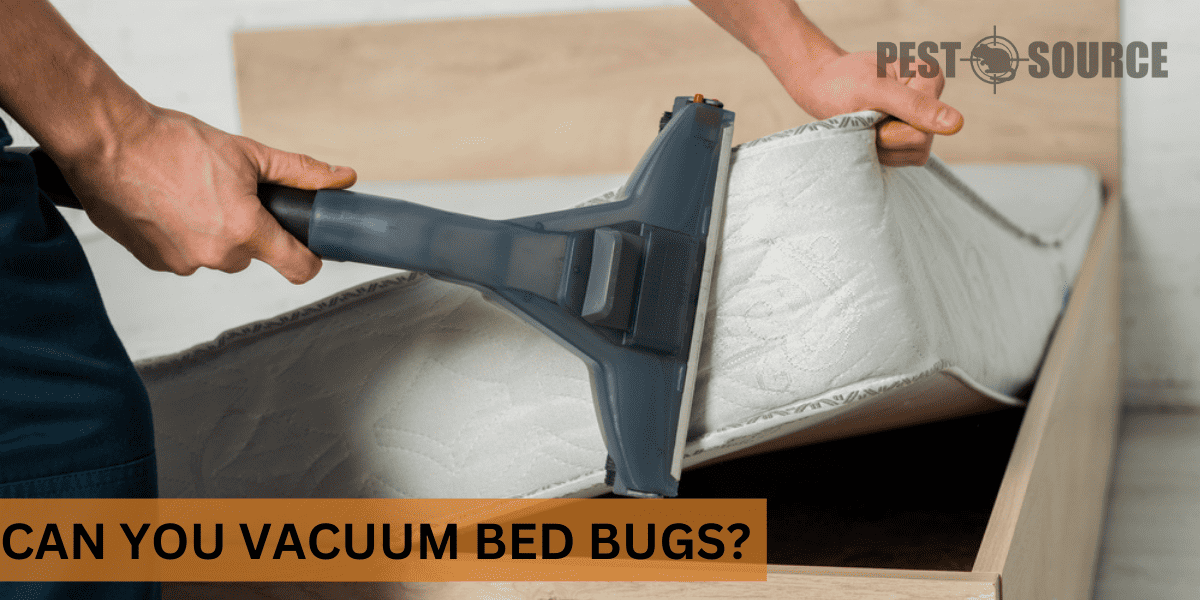Vacuuming can physically remove bed bugs from visible surfaces, including mattresses, furniture, and floors, making it a useful tool in the fight against these pests. However, vacuuming alone won’t eradicate an infestation, as it may miss hidden bugs and eggs. This article will guide you on how to effectively use a vacuum in your bed bug control strategy and what additional steps should be taken for complete removal.
POINTS
- Vacuuming bed bugs can help reduce their population by physically removing the visible ones from your premises, providing an immediate relief. However, vacuuming alone cannot completely eradicate bed bugs. These pests are notorious for their resilience and rapid reproduction rate, and their tiny eggs can often evade the vacuum.
- It’s crucial to immediately seal and dispose the vacuum bag or canister after vacuuming, preferably outdoors, to prevent re-infestation. Bed bugs can survive for several months within a vacuum cleaner or a sealed vacuum bag, highlighting the importance of handling the bags or canisters with care.
- Vacuuming should ideally be supplemented with other bed bug control methods such as heat treatments, insecticide applications, steam cleaning, regular inspections, and preventive measures to effectively manage an infestation.
- If the bed bug infestation continues despite your best efforts with vacuuming and other DIY methods, it may be time to call for professional help. Pest control experts have the knowledge, tools, and targeted methods to effectively treat bed bugs and offer longer-term solutions.
- As part of the conclusion, it’s important to remember that vacuuming is part of a larger, integrated pest management strategy. Understanding the role of vacuuming in bed bug management, while also adopting other effective methods and preventive steps, is key to solving the issue of bed bug infestations.
Understanding Bed Bugs and Vacuuming
Why do people consider vacuuming bed bugs?
Vacuuming is often considered as an initial response to a bed bug infestation because it’s a readily available, easy-to-use, and cost-effective tool in battling this pest. In addition to its convenience, vacuuming offers a chemical-free approach to capture and reduce the number of bed bugs, especially adults and larger nymphs, making an infestation more manageable.
How do bed bugs end up in our living spaces?
Bed bugs are excellent hitchhikers. They typically enter our homes unknowingly in luggage, used furniture, clothing, pillows, boxes, and other items. Once inside, they easily spread throughout a building, hiding during the day in places such as mattress seams, bed frames, headboards, furniture, behind wallpapers and picture frames – anywhere they can stay close to their human hosts for their next meal.
Can you vacuum bed bugs?
Yes, vacuuming can significantly help in picking up bed bugs. However, vacuuming shouldn’t be considered as the sole method of pest control for these resilient pests, but rather as a supplement to a comprehensive pest management strategy.
Does vacuuming kill bed bugs?
The act of vacuuming itself does not usually kill bed bugs, but it does remove them from the surfaces you have cleaned, making these areas temporarily safe. The bugs that survive vacuuming may still live inside the vacuum bag and could potentially escape if not handled correctly.
What is the impact of vacuuming on bed bugs?
Vacuuming plays a major role in physically reducing the bed bug population from your premises, ideally in combination with other treatments. Vacuuming will not necessarily eliminate all bed bugs, but it will lessen their number and prevent them from spreading further. However, vacuuming can unintentionally spread the infestation to other, previously uninfected areas, if not done carefully and properly.
The Process of Vacuuming Bed Bugs
How does vacuuming help with bed bugs?
Vacuuming plays a crucial role in physically reducing the bed bug population. This essential step in pest control management sucks up visible bed bugs, nymphs, and sometimes, even their eggs present in cavities, cracks, crevices, furniture, and bedding. Though not a standalone solution, it provides immediate relief and makes a considerable impact when used in conjunction with other pest control strategies.
What should one keep in mind when vacuuming bed bugs?
When vacuuming to eliminate bed bugs, it’s essential to pay meticulous attention to hiding spots. Vacuum all places where bed bugs may be hiding, including the mattress, box springs, bed frames, furniture, carpets, and even wall cracks. Remember also to immediately seal and dispose of the vacuum bag to avoid reinfestation and safely repeat the vacuuming process every few days.
What types of vacuums are recommended for bed bugs?
A vacuum with a strong suction and a crevice tool is ideally suited for dealing with bed bugs. Compressed air, found in certain vacuum models, can force bed bugs out from their hiding spots, and the strong suction ensures the bugs get drawn into the vacuum. Canister vacuums, for instance, can be a good choice given their powerful suction capabilities.
What are the correct steps to follow when vacuuming bed bugs?
Begin by attaching a nozzle on your vacuum to reach the tiny gaps where bed bugs often hide. Carefully vacuum all areas with a suspected presence of bed bugs, paying extra attention to hidden areas. Afterwards, it’s crucial to immediately seal and dispose of the vacuum bag to curtail further problems. This should ideally be done outdoors to prevent any escape of bugs back into your living spaces.
How to handle vacuum bags after vacuuming bed bugs?
After vacuuming, the bag or canister should be promptly and carefully removed, then sealed in a plastic bag. If your vacuum uses a bagless canister, empty the contents into a sealable bag. Following this, the bag or canister and the immediate area should be thoroughly cleaned and the sealed plastic bag should be disposed of in an outdoor trash receptacle. This is to prevent bed bugs from escaping and re-infesting your home.
The Effectiveness of Vacuuming Bed Bugs
Will vacuuming get rid of bed bugs?
While vacuuming can effectively get rid of bed bug population from your living spaces, it’s not a definitive solution. Bed bugs are notorious for their resilience and rapid reproduction rate, and their tiny eggs are often left behind even after a thorough vacuuming. Therefore, it is best used in conjunction with other pest control methods.
Can vacuuming kill bed bugs eggs?
The vacuuming process might suck up some bed bug eggs, but not all of them. Bed bug eggs are extremely small and sticky, often hidden deep inside cracks and crevices, and therefore can be tricky to entirely remove with a vacuum.
Does vacuuming your mattress get rid of bed bugs?
Vacuuming can indeed reduce the number of bed bugs on your mattress, but it doesn’t guarantee complete eradication. Bed bugs are skilled hiders, and their eggs are frequently found deep in mattress seams and box springs—areas that can be challenging for a vacuum to reach.
Can vacuuming eliminate bed bugs entirely?
Unfortunately, no. While vacuuming can dramatically reduce the number of bed bugs, it cannot completely eliminate them. This is because vacuums cannot always reach all the hidden cracks and crevices where these elusive insects and their eggs hide.
How effective is vacuuming in managing bed bug infestations?
Vacuuming can be very effective in managing an immediate bed bug issue, especially in the early stages of an infestation when the population is relatively small and concentrated. By removing the visible insects, you can slow the infestation’s growth and make other treatments more effective.
Can vacuuming also be effective against other pests like ants and cockroaches?
Yes, vacuuming can help manage other pests like ants and cockroaches. Just like bed bugs, these pests can also be sucked up, and their populations can be reduced with regular vacuuming. However, as with bed bugs, vacuuming alone isn’t sufficient to entirely eliminate these pests. A comprehensive approach involving pest-specific treatments is necessary for complete eradication.
The Risks and Challenges in Vacuuming Bed Bugs
Can bed bugs survive in vacuum cleaners?
Yes, bed bugs can indeed survive in vacuum cleaners. They can live for up to several months without a meal, and the environment inside a vacuum bag or canister can provide enough shelter for them to survive.
How long can bed bugs live in vacuum cleaners or sealed vacuum bags?
Bed bugs are hardy and resilient insects. They can survive in vacuum cleaners or sealed vacuum bags for several months, depending on the conditions. Warm environments can shorten their survival period, while cooler temperatures can prolong it.
What precautions should be taken to prevent bed bugs from surviving inside vacuum cleaners?
To prevent bed bugs from surviving inside vacuum cleaners, you need to properly manage the vacuum bag or canister post-vacuuming. Immediately seal it in a plastic bag, dispose of it in an outside garbage bin, and thoroughly clean the vacuum and surrounding area. If you have a bagless vacuum, wash and dry the canister at high temperatures to effectively kill any bed bugs that might be inside.
What are the dangers associated with vacuuming bed bugs?
One potential danger with vacuuming bed bugs is the chance of spreading the infestation unintentionally. Bed bugs can escape from the vacuum if not properly contained and infest other areas. Also, the vacuum cannot reach every nook and cranny where bed bugs lurk, potentially leaving some bugs and eggs behind.
Can bugs escape from a vacuum cleaner after being sucked in?
While it’s possible for smaller or more robust insects to survive the vacuuming process and escape later, bed bugs are generally not one of these types. However, improper handling or storage of the vacuum bag or canister post-cleaning can lead to bugs finding their way out, underlining the importance of careful vacuum disposal.
Best Practices for Vacuuming Bed Bugs
What is the best vacuum for bed bugs?
Canister vacuums generally come with strong suction and crevice tools, apt for cleaning tight spots where bed bugs dwell. Specific vacuums designed to handle bed bugs are also available; these come with powerful suction, sealed systems, and built-in HEPA filters that effectively trap and contain the pests inside the vacuum.
Are there specific vacuum brands or models that are more effective for bed bugs?
While there are no vacuum brands specifically designed to tackle only bed bugs, some models are better equipped for heavy-duty cleaning and can aid in bed bug control. These models usually feature powerful suction, crevice tools, a sealed system, and HEPA filters. Models from brands like Dyson, Miele, or Shark that include these features could prove to be more effective against bed bugs.
What types of vacuum cleaners are best suited for vacuuming bed bugs?
Vacuums that have powerful suction, crevice tools, and HEPA filters are best suited for dealing with bed bugs. The crevice tools allow access to hard-to-reach spaces, while HEPA filters help in trapping the bugs inside. Canister vacuums or bug-specific vacuum models are generally the most effective.
Can bagless vacuums be used for bed bugs?
Bagless vacuums can be used for vacuuming bed bugs; however, careful handling is necessary. Since these machines store the collected dust and bugs directly in the canister, immediate and thorough cleaning of the canister is required after use to eliminate any remaining bed bugs.
What precautions should be taken when using bagless vacuums for bed bugs?
When using a bagless vacuum for bed bugs, ensure to empty the canister into a sealable bag immediately after use. This bag should then be sealed and disposed of in an outdoor trash bin. The vacuum canister and the surrounding space should be cleaned thoroughly post disposure. It’s also recommended to clean the canister with hot water to kill any remaining bugs effectively.
Vacuuming After Bed Bug Treatment
Can you vacuum after a bed bug treatment?
Yes, vacuuming after a bed bug treatment can significantly help in removing dead bugs and residual debris, thus aiding in cleanup. It’s also an effective way to get rid of any bugs that might have survived a treatment, especially if it has been a few days since the last treatment was applied.
How long after bed bug treatment can you vacuum?
The timing depends on the type of treatment used. As a general guideline, give the treatment some time to work, usually a few hours to a day, before vacuuming. However, it’s always prudent to follow the specific instructions provided by the pest control professional or the treatment product’s manual.
Are there any potential problems with vacuuming after a bed bug treatment?
There are few potential problems. One is that vacuuming immediately after treatment might remove some of the applied pesticides before they have had a chance to work effectively. Therefore, waiting for a suitable duration post-treatment is advised. The second possible issue is that if the vacuuming is not done thoroughly, some bugs and eggs may remain, allowing the infestation to continue. Lastly, improper disposal of vacuum bags after treatment can result in reinfestation.
Vacuuming as Part of an Integrated Pest Control Strategy
What is the role of vacuuming in a larger pest control strategy?
In the battle against bed bugs, vacuuming plays a role of primary cleanup—it acts as an effective tool for rapid and substantial reduction in the population of active, visible bed bugs. Consider it as a first-aid measure that provides immediate relief but not a permanent solution. Thus, vacuuming is a critical part of an integrated pest management strategy that involves various steps including, but not limited to, heat treatment, use of pesticides, and regular inspections.
What other steps need to be taken in addition to vacuuming to effectively deal with a bed bug infestation?
Along with vacuuming, steps such as regular inspection, professional pest control services, heat treatment, use of pesticides, and preventive measures should be included in your pest control strategy. Washing your bedding and clothes in high heat, using protective covers on your mattress and box spring, decluttering, and sealing off cracks and crevices can also be beneficial in eliminating these pests.
Can vacuuming be an effective tool after professional pest extermination?
Certainly! Vacuuming after professional pest extermination can help clean up dead bugs and any lingering debris. It can also help pick up any surviving bugs, especially if it’s been a few days since the exterminator’s visit. Always remember to dispose of the vacuum bag or clean the canister thoroughly after each use.
Professional Help and Extermination Methods
Beyond vacuuming, what other methods exist for controlling bed bugs?
A variety of effective methods exist for controlling bed bugs, including heat treatments, insecticide applications, steam treatments, and the use of encasements. In addition, robust prevention strategies such as regular inspections, maintaining cleanliness, and promptly addressing any signs of an infestation can significantly help in controlling these pests.
When should you consider calling a professional for bed bug extermination after trying vacuum for bed bugs?
If the infestation continues despite regular and meticulous vacuuming, it may be time to call for professional pest control services. Professionals have extensive knowledge and tools to effectively treat bed bugs and offer longer-term solutions, such as preventing a future re-infestation.
What does a bed bug exterminator do differently than a DIY method like vacuuming?
Bed bug exterminators follow a comprehensive approach to extermination. They conduct a detailed inspection to assess the severity of the infestation, then use professional-grade tools and targeted methods—heat treatment, insecticides, and steam, among others—to effectively eliminate bed bugs. They also offer preventive advice and services to help ensure the bugs don’t return.
What alternatives to vacuuming are available for managing bed bug infestations?
Heat treatments, steam cleaning, use of insecticides, and hiring a professional exterminator are among the alternatives. Prevention strategies like sealing off potential entry points, using high heat to launder infected items, and maintaining overall cleanliness can also be effective.
How do other methods of pest control, such as professional extermination, compare to vacuuming in terms of effectiveness?
When compared to vacuuming, professional extermination is typically more effective in completely eliminating a bed bug infestation. While vacuuming provides initial relief by reducing the visible population, exterminators use an integrated approach that targets the bugs at all stages of their life cycle and from all hiding spots, resulting in a much more thorough and lasting resolution.



